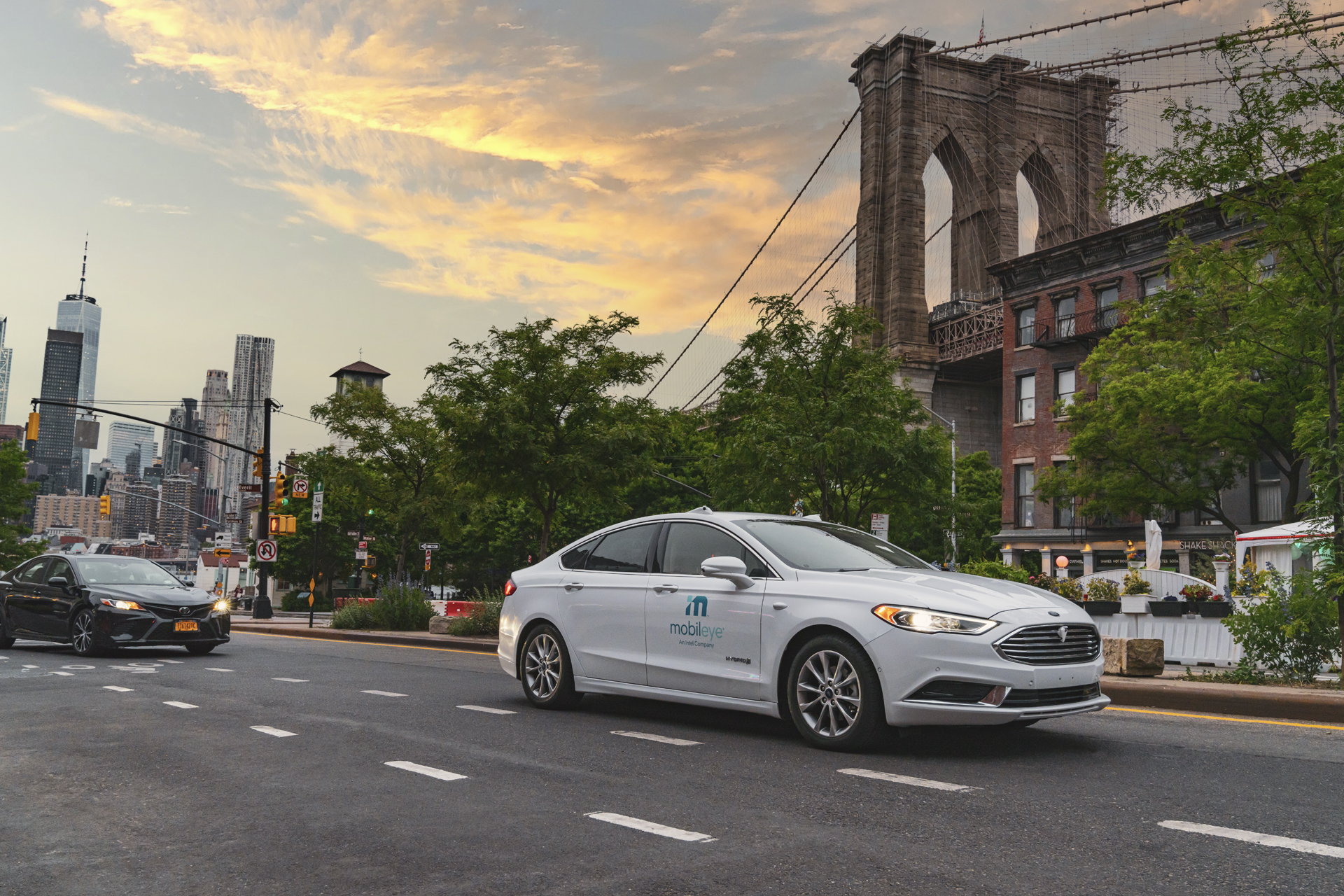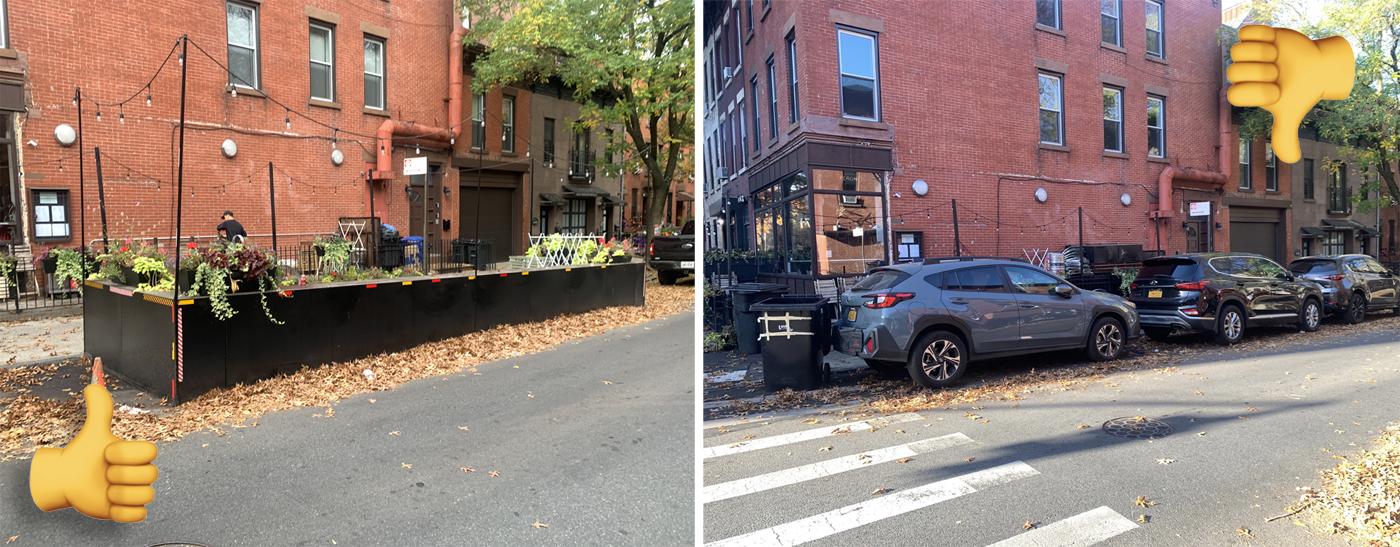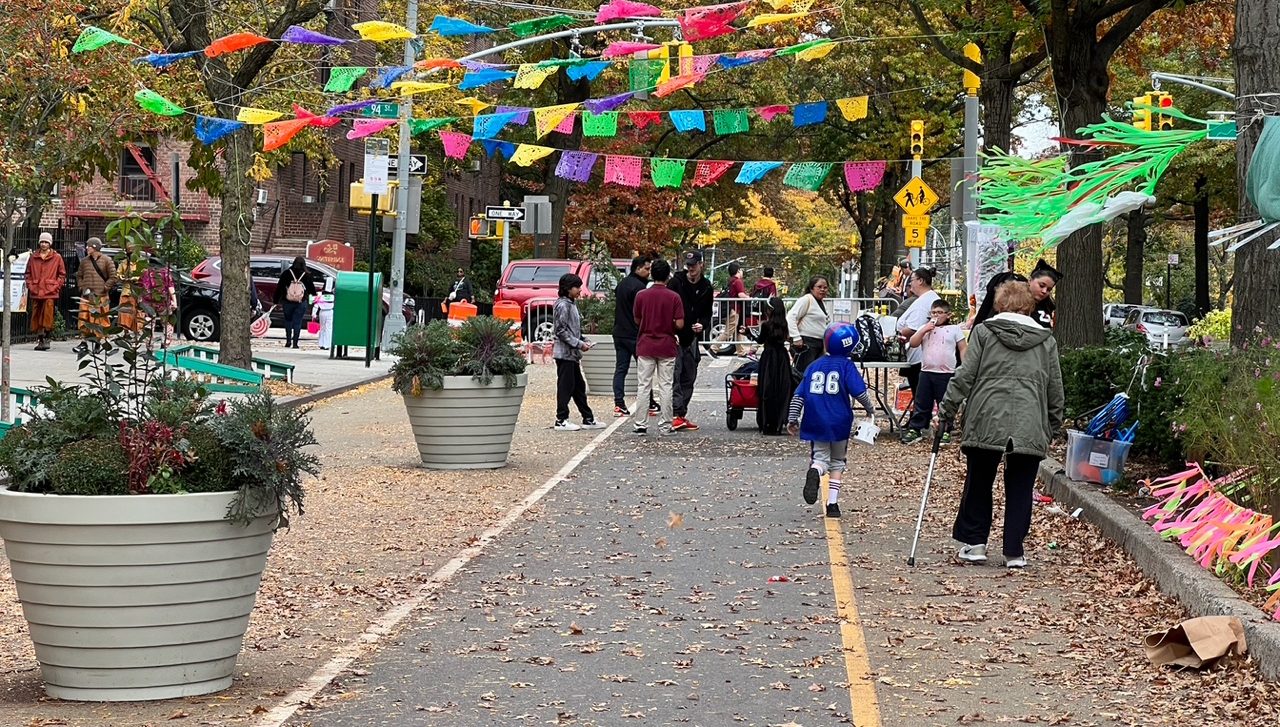Wait a minute — there’s going to be another one of those things out there? And then five more?!
A tech firm that has been quietly testing a single self-driving car on the streets of New York City — which prompted the Department of Transportation to initiate a process to further regulate the testing of such driverless vehicles — is about to deploy a second “look-ma-no-hands” car in Gotham this month, with plans for five more by the end of the year, Streetsblog has learned.
Mobileye — a division of Intel — has been quietly operating one camera-covered AV car in the city since June, but this month, after the DOT moved to require a specific city-issued permit for such testing, the company revealed through a spokeswoman that it will double that fleet in September. (Prior press accounts inaccurately said that the company was testing two AV cars already.)
The fleet of autonomous vehicles will grow to seven “in the next few months,” added Amnon Shashua, the Israeli computer scientist and president and CEO of Mobileye in a sparsely attended stock industry briefing last month that has been seen by few people. Shashua said the company’s testing in New York City — after similar run-throughs in Detroit and Munich — is critical to the future of self-driving cars for a simple reason well known to all New Yorkers: it’s impossible to drive here safely.
“In New York City, we gain all the learning we want to gain [in] AV testing,” he said. “It is really really challenging [to drive in New York], even for a human.”
You’re the guinea pig
There is no evidence that Mobileye’s testing in New York City has, thus far, gone Westworld on us. But that doesn’t mean there aren’t concerns. Legally, the company is currently operating in the Big Apple under a state permit — Mobileye is the only company that has been granted permission to test self-driving cars, according to the state Department of Motor Vehicles.
But the prospect of having seven inhuman machines driving around town led the DOT to announce a new regime for testing — one that will kick off with a rules hearing at 10 a.m. on Sept. 1 [Zoom link here, password: 043304]. The new city permit will require companies to self-certify “that their autonomous vehicles will operate more safely than human drivers in New York City,” submit “a safety plan,” and carry $5 million in insurance to “indemnify the city against legal liabilities”; and provide information about any collisions. The DOT must also be allowed to take a ride in the autonomous car as a “demonstration of the autonomous vehicle technology.”
Failure to get the permit will result in $5,000-per-day fines — a pittance to a company like Intel. (At that rate, a year of unpermitted testing would cost just $1.8 million for Intel, which has a market cap of $216 billion.)
The city has said it wanted the additional permit beyond the state permission because New York City streets need to be regulated by New York City’s transportation officials.
“New York City has the right to ensure the safety of its streets — that includes regulating autonomous vehicles that operate here,” said City Hall spokesman Mitchell Schwartz. “We won’t hesitate to take action against companies who could put pedestrians, cyclists, or other drivers in harm’s way.”
Harm’s way? Wut?
People who believe in the future of autonomous driving — people like Amnon Shashua, for example — believe, perhaps rightly, that computer-driven cars will inevitably be safer than flawed, slow-brained, dim-witted, frequently inebriated humans, if they are not already. But there’s another narrative within the AV world that emerges when you listen to driverless-car advocates talk about the technology when they are talking to enthusiasts outside the billions of people who will be affected by this technology. All of us, frankly, are in the dark about how this technology is being developed. Even the fatal crash of a driverless Uber cab in Arizona in 2018 — caused because the company had reduced its safety standards so that the AV system wouldn’t stop so often — raises questions to this day.
But every so often, a company official gives information to industry insiders that sheds real light on how tech people see the rest of us. Such a case happened on July 21 when Shashua gave a seminar, “Announcing Autonomous Vehicle Testing in New York.”
Throughout the video, Shashua referred to Mobileye’s work in New York as “battle testing” and used combat themes to describe the work his company is doing here.
“Battle testing of AV is very challenging in New York,” he said. “If we want to build at scale, we have to drive in places that are challenging. … And scale is important. You cannot build a business unless you can operate at scale.”
He described Mobileye’s system — it’s basically a car covered with 12 cameras that are working in conjunction with a massive database of images that form a topographical map of the city. Unbeknownst to most consumers, there are millions of cars on the road today whose front-facing cameras are taking pictures all the time and uploading them to the cloud; currently, Shashua said, the company receives 8 million kilometers of road pictures every day. As a result, the company’s 3D map of the city is quite robust.
“It is not the navigation map that we all use,” Shashua said of the database. “It is understanding every piece of detail of the road: where are the traffic lights. the association between lights and drivable paths, what are the drivable paths in an urban setting, the association between the priority of drivable path, the location of lanes and boundaries like curb and so forth — to centimeter detail. New York is completely mapped.”
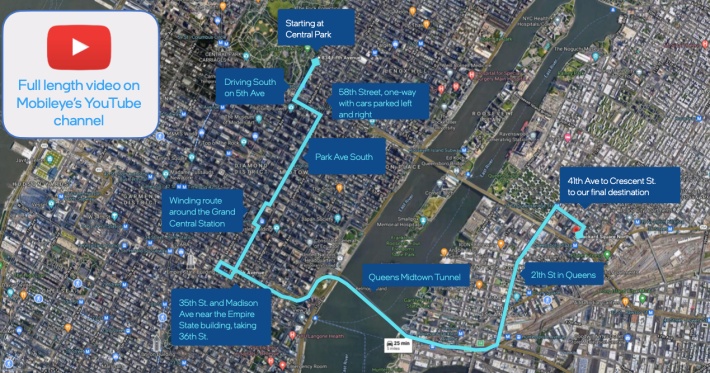
But the theme that Shashua kept coming back to was the difficulties of driving in New York City, with five main things that “stand out” in New York versus other world capitals:
- “Pedestrians and jaywalking”: “In New York City, this is really a class of its own. Pedestrians don’t respect the rules. When I’m in California and everywhere else in the world, if there is a red light, [pedestrians] don’t cross. In New York City, you cross. That’s New York City. You have jaywalkers and pedestrians and you have tons of them.” He made it sound as if everything would be so much easier if the pedestrians could be reformed.
- “Driving behavior”: “People here are very very assertive because the majority of drivers here are professional drivers. Whether they are Uber, Lyft or taxis, they are driving because they need to make their living. They don’t have time to be polite. The culture here is very, very aggressive when the traffic is congested. It is unlike everywhere else. People complain about Boston, but New York City is much worse.”
- “Light pollution”: “There is no night here in the city,” he said.
- “Double-parking”: “You have double-parking everywhere,” he said, making it “quite tricky” for an autonomous car to determine whether the “vehicle in front of it is an obstacle and not just standing in a line in a traffic jam. The car driving in New York City needs to make that decision every 100 meters. [The car has to calculate] ‘What is an obstacle I need to overate and what is a car that is just standing in a jam and I have to be patient.’ It is very tricky.”
- “Road users diversity”: You have carriages pulled by horse and so many different types of road users beyond pedestrians. You don’t find this in other cities.”
“It’s really a huge headache to test here in New York City,” he concluded.
On the road again
Shashua then showed techies a 40-minute video of the Mobileye Ford Focus actually driving itself around town, in a route from Fifth Avenue near Central Park to Sunnyside, Queens. Here’s the video:
What you see from the multi-screen footage is a car making its way around New York safely. The car is sometimes slow to make a decision, especially about passing a double-parked truck, but it clearly errs on the side of not endangering anyone (though its by-the-book approach to driving encourages less morally rigid drivers to cut around it as it waits patiently for a pedestrian or oncoming traffic to pass). But it’s also nice to see the car automatically move a bit to the right when a moped rider illegally passes it on the left. Then again, the car also routinely goes through yellow lights (and even went through two red lights making right turns, though no pedestrians were present).
It’s important to note that Mobileye chose a route with few turns, meaning fewer possible conflicts with pedestrians, and on a day when there were almost no cyclists on the road. That said, the car suffers a weird brain fart at 41:05 on the video, when it can’t seem to decide what to do as it tries to make a right turn onto Crescent Street in Astoria — then eventually goes through a red light.
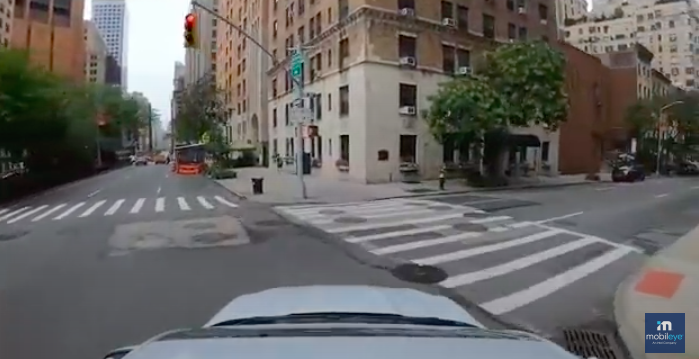
The video cuts out seconds later just as the Mobileye machine is about to tackle a particularly thorny situation involving an illegally parked Postal Service truck, a line of traffic and a protected bike lane at the entrance to the 59th Street Bridge in Queens. (Too bad the video ends; we would have loved to have seen whether it handled the problem well, or merely leaned on its horn and then drove in the bike lane like most New York drivers.)
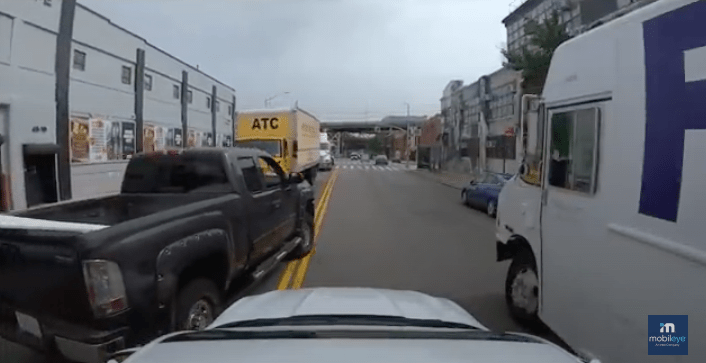
In a brief question-and-answer session, Shashua presented himself as someone who sees a problem — in this case, the danger of New York City’s streets and driving culture — as something simply to be solved with technology. One person asked how autonomous vehicles can even operate in a city with such “aggressive” pedestrians as New York.
Shashua said (and the video confirmed this) that Mobileye’s technology allows the car to sort of act as if it is being driven by a human.
“I’ll give you an example of changing lanes,” he said. “If you put on a turn signal, no one even cares. So what do you do? You start to merge and you do it carefully [with] distances that you keep [between cars] in such a way that your nudging is safe. Same thing with pedestrians. If you simply stand there, the pedestrian will continue crossing and you will never move. So you start moving slowly, nudging, nudging, signaling your intention that you are about to pass, but doing it in a way that you keep distances that are safe.”
But he stopped short of explaining what happens when pedestrians resist the efforts of a computer to tell them what to do.”I can think of all kinds of adversarial situations where the pedestrian knows it’s an AV and it wants to keep it from moving. Let’s keep that [discussion] for another time.”
In the end, Shashua was asked if AV cars are even feasible in a world of flawed human drivers, pedestrians, cyclists and road designers. His answer: It has to be or else no one is going to make any money.
“If you can conquer New York City, then it opens up very very big parts of the world to deploy this technology,” he said. “You have to battle test in difficult areas.”
But he said he doesn’t want his machines to overpower man … at least not yet.
“No one is going to heed my advice in New York, especially drivers.” he said. “[As tech developers], we need to manage with what we have. We are not going to change the DNA of New Yorkers. We need to drive safely within that DNA.”
To comment on the city’s proposed rules for AV testing, you can:
The deadline for written comments is at 5 p.m. on Wednesday, Sept. 1, 2021.
AV Proposed Rules_Notice of Public Hearing 07-30-21v3 by Gersh Kuntzman on Scribd
